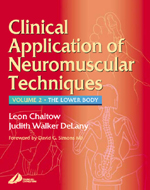Section 1. Essential information
Making sense of the picture. Connective tissue and the fascial
system. Fascia and its nature, Fascial tensegrity, Facial
postural patterns , Essential information about muscles, Muscle
energy sources, Muscle blood supply, Major types of voluntary
contraction, Muscle types, Cooperative muscle activity,
Contraction, spasm and contracture, What is muscle weakness?,
Reporting stations and proprioception, Reflex mechanisms,
Facilitation - segemental and local, Manipulating the reporting
stations, Therapeutic rehabilitation using reflex systems,
Trigger point formation , Central and attachment trigger points,
Trigger point activating factors, Ischemia and trigger point
evolution, A trigger point's target zone of referral, Key and
satellite trigger points, Trigger point incidence and location,
Trigger point activity and lymphatic dysfunction , Local and
general adaptation, Somatization - mind and muscles, Respiratory
influences, Patterns of dysfunction, The big picture and the
local even, Thoughts on pain symptoms in general and trigger
points in particular.
Section 2. Posture, acture and balance
Static and dynamic posture, Key postural influences, Is there an
ideal posture?, Gravitational influences and muscles,
Therapeutic objectives, Muscle categorizations, Necessary
assessments, Static postural assessment, Tools of postural
assessment, Plumb line, Postural grid, Portable units,
Computerized assessment methods, Basic postural assessment,
Standing postural assessment , Supine (non-weight bearing)
postural assessment, Assessment for freedom of movement, Other
postural models, Posture and the mind, Latey's lower fist, Good
posture and asymmetrical normality, Patterns of use and posture,
Additional local features influencing posture and use,
Exteroceptive and proprioceptive postural controls, Mechanisms
which alter proprioception, Common causes of postural imbalance
and retraining options , 'Normal' balance is age related, Causes
of disequilibrium, Stabilization, Disequilibrium rehabilitation
goals and strategies.
Section 3. Gait analysis
Normal joint and segment motion during the gait cycle,
Musculoligmentous slings and influences and the gait cycle ,
Energy storage during gait, Potential dysfunctions in gaiting,
Observation of gait, Multiview analysis, Muscular imbalance and
gait patterns, Chains of dysfunction, Liebensons clinical
approach, Altered hip extension, Altered hip abduction, Various
pathologies and gait, Neurological gait patterns, Pediatric
gait, Podiatric considerations and gait
Section 4. The close environment
The bodyworker's close environment, Acture guidelines for
bodywork students and practitioners, Automobile influences,
Driving: the vibration factor, Automobile risk factors,
Seatbelts and airbags, Gender issues in accident after-effects,
Multiple symptoms and fibromyalgia syndrome(FMS) following
vehicle injuries, The vehicle injury close environment, Sitting
on an airplane, Shoes, Neutral entrapment and shoes, Orthotics,
Effects of clothing, jewelry, other accessories and aids,
Sitting posture, Chairs as a health hazard, Better chair design
as an answer, Chair criteria, An Alexander perspective on
correct sitting, The art of sitting down, What are the risks of
poor sitting habits?, Computering work and posture, Sleeping
positions, Repose, Changing sleeping position due to nasal
influences, Problems relating to the posture of musicians,
Examples, Assessment, Conclusion.
Section 5. Adaptation and sport
First principles, An osteopathic perspective, Specific
adaptation to imposed demand ('training'), Training variations,
Strength training, Edurance training, Sprint training,
Overtraining issue, Overuse injuries and the young soccer
player, How widespread is the problem of overuse injury in
youngsters?, Prevention of overuse injuries, Sig


